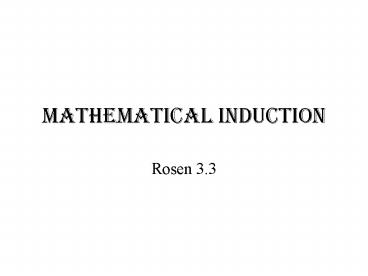Mathematical Induction PowerPoint PPT Presentation
Title: Mathematical Induction
1
Mathematical Induction
- Rosen 3.3
2
Basics
- The Well-Ordering Property - Every nonempty set
of nonnegative integers has a least element. - Many theorems state that P(n) is true for all
positive integers. - For example, P(n) could be the statement that the
sum of the first n positive integers 123 . . .
n n(n1)/2 - Mathematical Induction is a technique for proving
theorems of this kind.
3
Steps in an Induction Proof
- Basis step The proposition is shown to be true
for n1 (or, more generally, the first element
in the set) - Inductive step The implication P(n)?P(n1) is
shown to be true for every positive integer n
(more generally, for every integer element above
a lower bound, which could be negative). - For n?Z
- P(1)??n(P(n)?P(n1)) ??nP(n)
4
ExampleIf p(n) is the proposition that the sum
of the first n positive integers is n(n1)/2,
prove p(n) for n?Z.
- Basis Step We will show p(1) is true.
- p(1) 1(11)/2 2/2 1
- Inductive Step
- We want to show that p(n) ? p(n1)
- Assume 1234. . . n n(n1)/2
- Then 1234. . . n (n1) n(n1)/2 n1
n(n1)/2 (n1)(2/2) - n(n1) 2(n1)/2 n2 3n 2/2
(n1)(n2)/2 - Since p(1) is true and p(n) ? p(n1), then p(n)
is true for all positive integers n.
5
If p(n) is the proposition that the sum of the
first n odd integers is n2, prove p(n) for n?Z
- Induction Proof
- Basis Step We will show that p(1) is true.
- 1 12
- Inductive Step
- We want to show that p(n) ? p(n1)
- Assume 1 3 5 7 . . . (2n-1) n2
- Then 1 3 5 7 . . . (2n-1) (2n 1)
n2 2n 1 (n1)2 - Since p(1) is true and p(n) ? p(n1), then p(n)
is true for all positive integers n.
6
If p(n) is the proposition that prove
p(n) when n is a non-negative integer.
- Inductive Proof
- Basis Step We will show p(0) is true.
- 20 1 2-1 201 -1
- Inductive step We want to show that p(n) ?
p(n1) - Assume 20 21 22 23 . . . 2n 2n1 - 1,
then - 20 21 22 23 . . . 2n 2n1 2n1 - 1
2n1 - 2(2n1) -1 2n2 - 1
- Since p(0) is true and p(n) ? p(n1), then p(n)
is true for all nonnegative integers n.
7
More General Example
- Let p(n) be the statement that n! gt 2n. Prove
p(n) for n ?4. - Inductive Proof
- Basis Step We will show that p(4) is true.
- 4! 24 gt 24 16
- Inductive Step We want to show that ?k?4, p(k)
?p(k1). Assume k! gt 2k for some arbitrary k?4.
8
n! gt 2n (cont.)
- (k1)! (k1)k!
- gt (k1)2k (inductive hypothesis)
- gt 22k (since k?4)
- 2k1
- Since p(4) is true and p(n) ? p(n1), then p(n)
is true for all integers n?4.
9
Let p(n) be the statement that all numbers of the
form 8n-2n for n?Z are divisible by 6 (i.e., can
be written as 6k for some k?Z). Prove p(n)
- Inductive Proof
- Basis Step We will show that p(1) is true.
- 81-21 6 which is clearly divisible by 6.
- Inductive Step We must show that ?k?Z (8k-2k)
is divisible by 6?(8k1-2k1) is divisible by 6.
10
Divisible by 6 Example (cont.)
- 8k1 - 2k1 8(8k) - 2k1
- 8(8k) -8(2k) 82k - 2k1
- 8(8k-2k) 82k - 2k1
- 8(8k-2k) 82k - 22k
- 8(8k-2k) 62k
- By the inductive hypothesis 8(8k-2k) is
divisible by 6 and clearly 62k is divisible by
6. Thus 8k1 - 2k1 is divisible by 6. Since p(1)
is true and p(n) ? p(n1), then p(n) is true for
all positive integers n.
11
Prove that 21 divides 4n1 52n-1 whenever n is
a positive integer
- Basis Step When n 1, then 4n1 52n-1
411 52(1)-1 425 21 which is clearly
divisible by 21. - Inductive Step Assume that 4n1 52n-1 is
divisible by 21. We must show that 4n11
52(n1)-1 is divisible by 21.
12
- 4n11 52(n1)-1 44n1 52n2-1
- 44n1 2552n-1
- 44n1 (421) 52n-1
- 4(4n1 52n-1) 2152n-1
- The first term is divisible by 21 by the
induction hypothesis and clearly the second term
is divisible by 21. Therefore their sum is
divisible by 21.
13
Second Principle of Mathematical Induction
(Strong Induction)
- Basis Step The proposition p(1) is shown to be
true. - Inductive Step It is shown that p(1)?p(2)?
?p(n) ? p(n1) is true for every positive
integer n. - Sometimes have multiple basis steps to prove.
14
Example of Strong Induction
- Consider the sequence defined as follows
- b0 1
- b1 1
- bn 2bn-1 bn-2 for ngt1
- 1,1, 3,7, 17,
- b0, b1, b2, b3, b4,.
- Prove that bn is odd
15
Inductive Proof Using Strong Induction
- Basis Cases (One for n0 and one for n1 since
the general formula is not applicable until ngt1,
but it involves both b0 and b1.) - b0 b1 1 so both b0 and b1 are odd.
- Inductive Step
- Consider kgt1 and assume that bn is odd for all 0
? n ? k. We must show that bk1 is odd.
16
Proof Example (cont.)
- From the formula we know that
- bk1 2bk bk-1. Clearly the first term is
even. By the inductive hypothesis the second
term is odd. Since the sum of an even integer
and an odd integer is always odd (which we proved
in number theory), then bk1 is odd. - In this example we did not need all p(n), 0?n?k,
but we did need p(k) and p(k-1). Note that a
proof using weak induction would only be able to
assume p(k).

